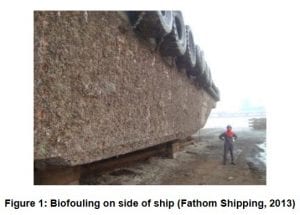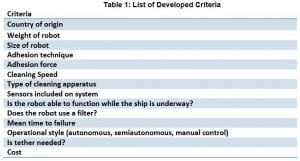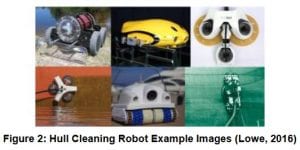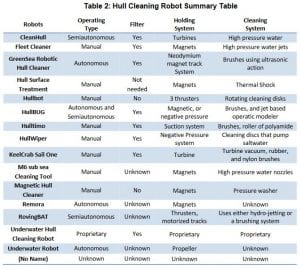Analyzing the Current Market of Hull Cleaning Robots
Authors
Andrew Patrick Curran, Evan Fitzgerald King, Carolyn Marie Lowe, Brendan Willstan O’Connor
Sponsor
United States Coast Guard
Advisors
James Hanlan, Stephen McCauley
Term
October – December 2016
Project Outcomes
Abstract
This project is intended to provide a market assessment of the emerging industry of hull cleaning robots to help the United States Coast Guard with their mission of reducing the spread of non-indigenous marine species. We researched the feasibility of these technologies that stakeholders need to be aware of, including the regulations and state of the market. The project resulted in a comprehensive list of every hull cleaner that we were able to identify and their functionality along with design parameters.
Executive Summary
Project Background
Biofouling is the buildup of organisms on the side of boat hulls, propellers, and other infrastructure in aquatic and marine environments. It causes a variety of issues for vessels of all types, including large tanker ships, military vessels, and personal watercrafts. Organisms on a ship’s hull increase fuel consumption by increasing the ship’s drag. Additionally, vessels can transfer marine species from one region of the world to another. When an invasive species is introduced to an ecosystem, there is often a disruption and damage to the environment. For example, new species may not have natural predators and could out-compete native species. The International Maritime Organization (IMO) Secretary-General recognizes invasive species as one of the greatest threats to the ecological well-being of the planet (International Maritime Organization, 2016a).
The United States Coast Guard (USCG), pursuant to the National Invasive Species Act, is interested in investigating new ways of controlling the introduction of invasive species in U.S. marine environments. Unfortunately, current methods for combating biofouling are expensive. Ships must be drydocked, cleaned of current coatings and fouling, and then painted with antifouling paint routinely depending on the class of vessel (Brogan, 2015). Any amount of time that a ship spends drydocked is time that is not spent in the water engaged in normal operations. Many ship owners periodically deploy divers to inspect ship hulls and remove biofouling, however, like drydocks, deploying divers is costly.
Hull cleaners are autonomous or semi-autonomous underwater robots used to scrub ship hulls clean while still in the water. As this is a fairly new industry, information on hull cleaners is scarce but what we have been able to find shows promise. Routine use of hull cleaners could result in fuel savings. Hull cleaning robots may also be able to reduce the risk of spreading invasive species.
Methodology
This project is intended to help the USCG understand what technologies are available today. In order to obtain effective and usable information for the Coast Guard we defined the following objectives:
- Identify potential hull cleaning systems and other hull cleaning technologies
- Determine a criteria for evaluating hull cleaning systems
- Gather information on both current hull cleaning technologies and ones currently in development
We began by identifying current hull cleaning technologies. It is important to stress that our list is nonexclusive and non-exhaustive.
We then defined the key functions and design limitations of the hull cleaners. This required two crucial steps. First, we determined the regulatory and economic constraints that influence robot design. Second, we investigated the functions that the robot would need to perform to meet the ship owners’ needs. We spoke with maintenance experts and naval architects from the USCG, but all of the shipping companies we contacted either did not receive our communication or chose not to reply.
After establishing criteria for hull cleaning robots, we contacted the companies we identified through our research. The criteria shaped our questions to the companies and allowed us to establish a baseline of information to collect. This baseline allowed us to be consistent in our research.
Results
The data we gathered shows the diverse set of hull cleaning robots that are out in the market today. As for any new industry, the technologies will need further development and testing in order to be successful. We compiled the results of all our findings into three different sections. The first section lists all the companies and organizations that are included. The second section describes potential design considerations for hull cleaners. The final section is a list of all hull cleaners and their specifications.
Identified Hull Cleaner Companies
Throughout the project we gained a substantial amount of information on the individual technologies both available and being researched. Since each hull cleaner is in different stages of development it is important to take a step back and properly evaluate the state of the market. Of the 16 hull cleaning robots identified three hull cleaners are from the United States. The remaining 13 are spread amongst eight countries. If we were unable to have a direct correspondence with the company, we still included any information we were able to gather on the robot.
In terms of the commercial availability of these robots, two of the 16 robots are from universities, and are primarily research projects. One project was cancelled, and one company is suspected of no longer being in business. The remaining 12 hull cleaning robots can be grouped into three categories. Six are in use today, or are commercially available. Five are still undergoing development and testing. The remaining robot’s status is unknown, because the company chose not to give us information on its status in any capacity.
Developed Criteria
To develop criteria on the functions and design limitations of hull cleaning robots, we needed to first understand what every stakeholder would require in these devices. Shipping companies are concerned with their continually shrinking bottom line. Robot manufacturers are attempting to develop technologies that function in a variety of circumstances and environments, primarily to save their customers fuel costs. Regulators face a difficult task in defining how to use this technology in order to combat invasive species. Based on this information, we determined the following criteria to be most important in researching hull cleaners.
Hull cleaning robot profiles
We gathered data of the hull cleaning robots, like the ones seen in figure 2, from their manufacturing companies and developers.
Table 2 is a list of each technology identified along with quick details about each device. Criteria include but are not limited to the method of operation, the onboard filtration system, the system of adhesion to the side of a ship, and the cleaning system the robot uses.
Observations on the Market of Hull Cleaning Robots
Our observations generally fit into three categories: economic, technical, and regulatory. Economic pressures and the development of robot technologies have allowed hull cleaning robots to quickly emerge as a new industry. The robots possess a diverse and powerful set of technical capabilities that need to be taken into account when looking at solutions to biofouling. Finally, the influence that state, federal and international regulations might have on hull cleaning robot design could shape the industry. Our observations are as follows.
Economic
The economic picture of hull cleaning robots is diverse and driven by a number of factors. This industry is relatively new and still needs a lot of time to mature, but we believe the industry is growing because many of the hull cleaners began development after 2010. Many of these companies advertise that their product can save the ship operators money through lower fuel consumption. This indicates that many of these systems will need additional testing in real world scenarios to confirm the veracity of claims made by industry. We believe that if margins narrow in the shipping industry (Morley, 2016), hull cleaning robots and other alternative fuel saving technologies will grow considerably.
Technical
From a technical perspective, the industry is also extremely diverse. Every company had different goals in mind when designing their robot and, consequently, different approaches to the problem. In terms of the effectiveness of the technologies, we continue to see a lack of conclusive testing. Many of these technologies have only been tested in a controlled environment, and many of the designs present potential concerns in an actual operating environment, e.g. a port or open waters.
An ideal robot would be able to work without disrupting the normal functions of the ship. One robot can perform their tasks while the ship is underway, but the rest are intended to clean the ship while it’s in port. Some ports have strict restrictions on hull cleaning which resulted in many companies installing filtration systems onboard their robots.
A great deal of evaluation and testing needs to be performed. There is very little independent testing being done on these technologies. Regulators or ship owners have no independent data determining the veracity of the robot manufacturers’ claims. As the industry continues to grow, the effectiveness of the technologies will need to be studied and determined
Regulatory
Regulations have influenced the development of hull cleaning robots through hull fouling limitations, hull coating restrictions, and prohibiting hull cleaning in port. State, federal and international regulators could positively or negatively affect the hull cleaning industry. If more biofouling regulations are implemented and enforced, hull cleaning robots will become increasingly relevant.
We believe that if regulations on robot hull cleaners were implemented, it is likely to negatively impact the industry. Robotic hull cleaner designs vary wildly, as each utilizes different approaches. This wide variance will make it extremely difficult to establish a definitive standard, even if performance based. If such a standard were to be implemented, creative and innovative solutions may suffer as companies compete to meet the standard.
Our data suggests that regulators have a lot to examine when discussing choices to make regarding hull cleaning robots. A full evaluation of the impacts on each stakeholder needs to be performed before any action is taken. Hull robots are a new and emerging industry, which will be affected by regulations created for addressing biofouling, fuel consumption and cleaning in ports.
Conclusion
This project will be the first report assessing the market of hull cleaning robots. We believe the report will be useful not only to the USCG, but to the shipping industry. We also created a reference binder detailing the different technologies we identified and presented our findings to the USCG. Hull cleaners are an emerging technology and much of their future is unknown, but we now know the state of the market.






